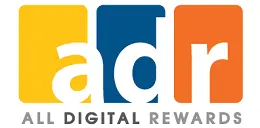
All Digital Rewards
Payments, prepaid/gift cards, checks, PayPal, sweepstakes, Points, API and Reward management software
Featured in Greenbook's Buyer's Guides
Why choose Us
PCI Compliant
Global
End to End Solutions
API
Hierarchical Reporting
Features and attributes
What is All Digital Rewards?
All Digital Rewards understands the basic principle of what drives a company’s success – people. It is our business to know how to motivate consumers, channel partners, employees, and respondents helping clients effectively design, build, launch, and manage programs for different audiences, without the high cost.
Recognition & Certifications


Research Software and Platform Details
Solution deployment
Cloud, SaaS, Web-Based
Pricing details
Annual subscription
Free version
Monthly subscription
Starting at Each. Per reward transaction
Support
Email / Help desk
Phone
Training
Custom
Documentation
Market Research Products
Services and Expertise
Explore market research solutions, industries, markets, and business issues covered by All Digital Rewards
Research Solutions
Industries & Demographics
Client Projects and Success Stories
4 results
Cash vs Blended Incentive Spend. Which Is Better?
An ADR market research client is spending large amounts of cash funds on loyalty reward projects and programs and is looking to cut their costs to be more efficient and competitive. Overall, the client is running two different programs: Program 1 includes several projects and programs that deliver reward incentives to participating panelists with a points-based mixed reward product marketplace. Program 2, which also includes several projects and programs similar to Program 1 but delivers cash based reward incentives to participating panelists Program 2, is the largest of the programs and has the highest costs overall.
Program 2 is only offering physical prepaid cards, virtual prepaid cards, and checks. All of which are cash based. The end users of this program are engaged at least once per month and sometimes as many as five times per month. Each time, the end user is offered a sum of money to complete the task. Since each end user is getting rewarded time and time again, the end user is habitually choosing one of the three rewards and has generated a habit in how they handle those funds. It is unusual that these rewards are being used for anything other than for paying bills or other daily trivial purposes.
The overall challenge is to evaluate the cost of the products for each program, the way the rewards are distributed, and see where savings on products can be applied. With the introduction of games into the incentive programs, we can examine both scenarios and determine which one is going to present the best method to drive behavior, drive retention, and improve cost efficiencies.
Lower Marketing Costs By Offering The Right Panel Incentive Reward Mix
No matter how popular your panel is, if you can’t create an incentive program in a cost effective manner then you just won’t make a good return on your investment. When your manufacturing facility is not producing the profit margins that you desire you’ll need to look around for some ideas that make sense to improve your channel sales along with survey employees and channel partners to inquire what you can do to make sure they feel valued.
At All Digital Rewards (ADR), a large automobile manufacturer came to us with this problem in hand. They wanted to eliminate cash/check reward incentives survey rewards to their dealerships and to create a program that would allow better education and communication between the managers and sales’ teams. ADR helped them do just that and more.
Instant Win Drawings Reduce Points Based Reward Program Costs And Improve Engagement
Every incentive program manager is faced with recruiting, surveying, engaging and retaining respondents. They are constantly looking for new promotions to deploy to drive respondent behavior to ensure that company and client stakeholders stay happy. Common problems panel managers are faced with stale promotional offerings, a tight budget, and a disconnected user experience. When we hear this from marketers, the first thing we look at is the marketer employing games in their marketing mix and if they are how are they implementing the game within their program.
Reward drawings are designed and deployed to impact consumer behavior and are meant to engage low point participant earners with and opportunity to exhange points and win a high perceived value prize item that is enticing enough to impact consumer behavior by increasing consumer engagement, and build brand advocacy of a points based program. A well designed promotional drawing or sweepstakes will accomplish all of the above. However, there are pitfalls to be avoided.
Reward drawings need to be carefully created, deployed, and managed to avoid legal, operational and financial pitfalls. Legal issues associated with a promotional drawing can have considerable ramifications. To avoid the considerable issues associated with drawings, it is often best to partner with an incentive marketing agency with expertise and experience in designing and managing promotional drawings.An effective incentive drawing does require a base level of volume.
To launch an effective incentive drawing program the reward mix must be attractive enough to impact behavior. Supporting a reward mix of $5,000 requires either a willingness to pay for rewards well in advance of distribution and have the drawing play out over a long period of time or sufficient volume to burn through the drawing entries available in a considerably shorter window
Research Resources
17 results
Teen Reward Card
Article
Revolutionizing Panel Recruitment: The Power of Incentive Programs and AI Optimization
Article
2023 Incentive Technology Buyers Guide; Part One Building The Case For Loyalty And Incentive Programs
Article
Market Research FAQs with Expert Insights
Greenbook experts provide answers to a wide range of questions, both common and uncommon, about market research and analytics that connect to the kinds of services and expertise All Digital Rewards offers.
Prepared by Greenbook editors. Technology was used in the editorial process.




